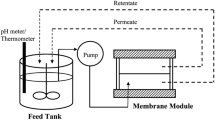Abstract
Adsorption of microcystins (MCs) by carbon nanotubes (CNTs) and clay materials was studied. Compared with various clays tested, CNTs showed a much stronger ability to adsorb MC-RR and LR that were two typical types of microcystins found in China. At initial 21.0 mg/L of MC-RR and 9.5 mg/L of MC-LR in solution, the adsorption amounts of MC-RR and LR by CNTs were 14.8 and 6.7 mg/g that were about five times higher than those by the clay materials of sepiolite, kaolinite and talc, etc. In the presence of CNTs and the bacterialRalstonia solanacearum that was firstly isolated and used for the biodegradation of MCs by the authors, a remarkable removal of MCs from water were observed. The mechanism was that CNTs could absorb large amount of both MCs and the embeddedR. solanacearum so that, even when diluted by a large amount of water, the concentrations of both organic pollutants and the added bacteria could be largely enhanced on the surface of CNTs where a concerted biodegradation reaction was effectively conducted. This finding could be important for the further development of practical techniques to eliminate MCs from polluted drinking waters.
Similar content being viewed by others
References
Gromov, B. V., Vepritsky, A. A., Mamkaeva, K. A. et al., A survey of toxicity of cyanobacterial blooms in Lake Ladoga and adjacent water bodies, Hydrobiologia, 1996, 322: 149–151.
Falconer, I. R., Toxic cyanobacterial bloom problems in Australian Waters: Risks and impacts on human health, Phycologia, 2001, 40(3): 228–233.
Harada, K., Recent advances of toxic cyanobacteria research, J. of Health Science, 1999, 45(3): 150–165.
Ichimura, T., Isolation and culture methods of algae, in Methods in Algological Studies (eds. Nishizawa, K., Chihara, M.) (in Japanese), Tokyo: Kyoritu Shuppan, 1979, 294–305.
Zhang, W. H., Xu, X. Q., Qiu, C. Q., Advance in study on microcystins in aquatic environment, Research of Environmental Sciences (in Chinese), 2001, 14(2): 57–61.
Duy, T. N., Lam, P. K. S., Shaw, G. R., Toxicology and risk assessment of fresh water cyanobacterial (Blue-green Algae) toxins in water, Rev. Environ. Contam. Toxicol., 2000, 163: 113–186.
Francis, G., Poisonous Australian lake, Nature, 1878, 18: 11–12.
Zimba, P. V., Khoo, L., Gaunt, P. S. et al., Confirmation of catfish,Ictalurus punctatus (Rafinesque), mortality fromMicrocystis Toxins, J. of Fish Diseases, 2001, 24(1): 41–47.
Pouria, S., A fatal microcystin intoxication in haemodialysis unit in Caruaru, Brazil Lancet, 1998, 352(2): 21–26.
Yan, H., Pan, G., Zhang, M. M., Advances in the study of microcystin toxin, Acta Ecologica Sinica (in Chinese), 2002, 22(11): 189–197.
Lin, Y. X., Liu, X. F., Yan, H. et al., Toxin ofMicrocystis aeruginosa Kuitz in Dianchi and its change in water body, Techniques and Equipment for Environmental Pollution Control (in Chinese), 2001, 2(5): 10–13.
Lian, M., Chen, C. W., Yu, S. Z. et al., The distribution of microcystin and its influence factors in Dianshan Lake in summer, China Environmental Science (in Chinese), 2000, 20(4): 323–327.
Dong, C. H., Yu, S. Z., Chen, G. et al., Detection of microcystins in water samples came from four zones and a lake of Jiangsu Province, Journal of Environ. and Health (in Chinese), 1998, 3: 111–113.
Meng, Y. Z. Zhang, D., Wang, X. G. et al., Study on the contamination of algae and microcystins in water sources of Zhengzhou City, Journal of Hygiene Research (in Chinese), 1999, 2: 100–101.
Dawson, R. M., The toxicology of microcystins, Toxicon, 1998, 36(7): 953–962.
Honkanen, R. E., Zwiller, J., Moore, R. E. et al., Characterization of microcystin-LR, a potent inhibitor of type 1 and 2a protein phosphatases, J. Biol. Chem., 1990, 265: 19401–19404.
Falconer, I. R., An overview of problems caused by toxic blue-green algae (cyanobacteria) in drinking and recreational water, Environmental Toxicol., 1999, 14(1): 5–12.
Tsuji, K. T., Watanuki, F., Stability of microcystins from cyanobacteria-IV, Effect of chlorination on decomposition, Toxicon, 1997, 35(7): 1033–1041.
Morris, R. J., Williams, D. E., Luu, H. A. et al., The adsorption of microcystin-LR by natural clay particles, Toxicon, 2000, 38: 303–308.
Feitz, A., Walte, D., Jones, G. et al., Photocatalytic degradation of the blue green algal toxin microcystin-LR in a natural organic-aqueous matrix, Environ. Sci. Technol., 1999, 33: 243–249.
Park, H. D., Sasaki, Y., Maruyama, T. et al., Degradation of the cyanobacterial hepatotoxin microcystin by a new bacterium isolated from a hypertrophic lake, Environ. Toxicol., 2001, 16(4): 337–343.
Warhurst, A. M., Raggett, S. L., McConnachie, G. L. et al., Adsorption of the cyanobacterial hepatotoxin microcystin-LR by a low-cost activated carbon from the seed husks of the pan-tropical tree,Moringa oleifera, The Sci. of the Total Environ., 1997, 207: 207–211.
Haider, S., Naithani, V., Viswanathan, P. N. et al., Cyanobacterial toxins: a growing environmental concern, Chemosphere, 2003, 52: 1–21.
Author information
Authors and Affiliations
Corresponding author
About this article
Cite this article
Yan, H., Pan, G., Zou, H. et al. Effective removal of microcystins using carbon nanotubes embedded with bacteria. Chin. Sci. Bull. 49, 1694–1698 (2004). https://doi.org/10.1007/BF03184300
Received:
Revised:
Accepted:
Issue Date:
DOI: https://doi.org/10.1007/BF03184300




